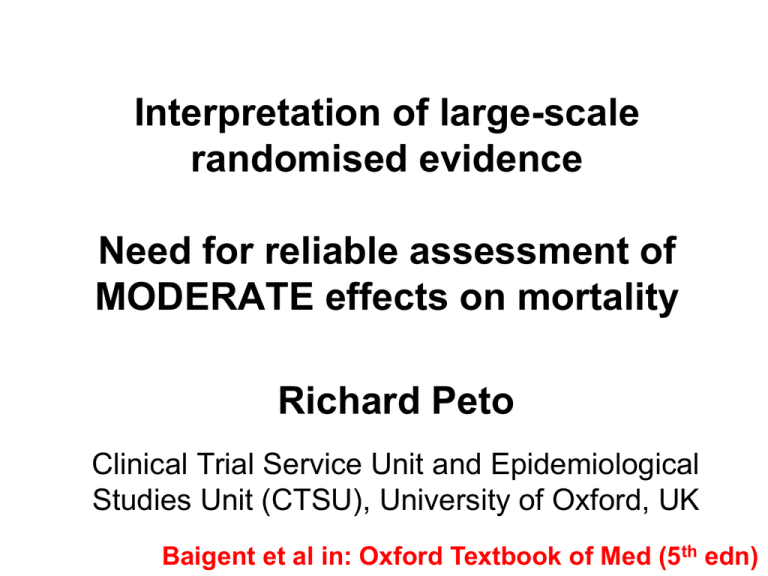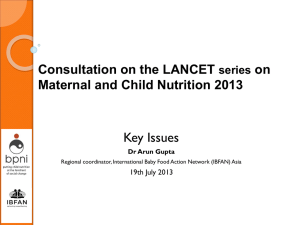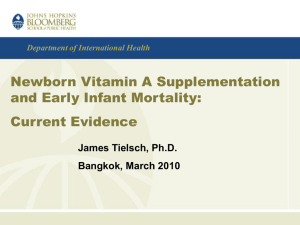Large-Scale Randomised Evidence
advertisement

Interpretation of large-scale randomised evidence Need for reliable assessment of MODERATE effects on mortality Richard Peto Clinical Trial Service Unit and Epidemiological Studies Unit (CTSU), University of Oxford, UK Baigent et al in: Oxford Textbook of Med (5th edn) Requirements for reliable assessment of MODERATE effects: NEGLIGIBLE biases, and SMALL random errors GUARANTEED AVOIDANCE OF MODERATE BIASES: - Proper randomization (non-randomised methods might suffer moderate biases) - Analysis by allocated treatment (including all randomised patients: ‘intention to treat’ analysis) - Chief emphasis on overall results (no unduly data-dependent emphasis on particular subgroups) - Systematic overview of all relevant randomised trials (no unduly data-dependent emphasis on particular studies) SMALL RANDOM ERRORS: - Large numbers in any new trials (to be really large, trials should be “streamlined”) - Systematic overview of all relevant randomised trials (which yields the largest possible total numbers) Baigent et al in: Oxford Textbook of Med (5th edn) Assessment of MODERATE differences in survival • Need all the main trial results, to avoid undue emphasis on particular studies • Likewise, avoid unduly data-dependent emphasis on particular subgroups Baigent et al in: Oxford Textbook of Med (5th edn) Low-dose aspirin in acute myocardial infarction (MI): strikingly positive result, but with some FALSE NEGATIVE subgroup analyses Lancet 1998; 332: 349 ISIS-2: aspirin for acute MI Lancet 1998; 332: 349 Lancet 1998; 332: 349 Magnesium in acute myocardial infarction (MI): meta-analysis of small trials REFUTED by big trials (so, a “random effects” meta-analysis of the trials would be misleading) Baigent et al in: Oxford Textbook of Med (5th edn) Magnesium infusion in acute myocardial infarction (MI): meta-analysis of small trials CONTRADICTED by big trial Baigent et al in: Oxford Textbook of Med (5th edn) Baigent et al in: Oxford Textbook of Med (5th edn) Fibrinolytic (clot-buster) in acute myocardial infarction: meta-analysis of small trials CONFIRMED by big trials Lancet 1994; 343: 311 Meta-analysis of small fibrinolytic trials (1959-85) Lancet 1994; 343: 311-22. Lancet 1994; 343: 311-22. Vitamin A supplementation and child mortality: estimated treatment effect from meta-analysis of 8 small trials was HALVED by including a big trial Lancet 2013; 381: 1469 Six-monthly vitamin A from 1 to 6 years of age DEVTA: cluster-randomised trial in 1 million children in North India Shally AWASTHI (KG Medical Univ, Lucknow, UP), Richard PETO & Simon READ (CTSU, Univ Oxford, UK), Donald BUNDY (World Bank, Washington, DC) et al. Lancet 2013; 381: 1469 DEVTA covers more than half (72/118) of the administrative blocks in 7 districts near Lucknow, the state capital of Uttar Pradesh, North India 7 DEVTA districts in Uttar Pradesh 1 Lucknow 2 Raibarelli 3 Unnao 4 Kanpur 5 Hardoi 6 Lakhimpur 7 Sitapur Lancet 2013; 381: 1469 NB Delhi to Kathmandu is 800 km (8 degrees of longitude); shaded area is 30,000 km2 Lancet 2013; 381: 1469 Pre-school rural North India • Vit A deficiency common • 2-3% die at ages 1-6 (mainly acute infection) • DEVTA: can 6-monthly vit A reduce this mortality? Lancet 2013; 381: 1469 DEVTA: cluster-randomised trial 8000+ villages in 72 clusters 36 blocks 6-monthly VITAMIN A 36 blocks allocated open CONTROL Also, visit all villages 6 monthly to get mortality (25,000 child deaths recorded) Lancet 2013; 381: 1469 Lancet 2013; 381: 1469 DEVTA vit A schedule, 1999-2004 200,000 IU vit A given on six-monthly mass-treatment days to all age 6-72m 86% compliance: Vitamin A group got ~9.5 of 11 doses (but, controls got ~1 non-trial vit A dose) Lancet 2013; 381: 1469 DEVTA: biomedical monitoring Annually, 1 random village per block visited and children examined for vit A deficiency Bitot’s spots 1.4% vs 3.5%, 2p<0.01 (comparing 36 vit A vs 36 control clusters) Plasma retinol < 0.35 μM/L (10 μg/dL), ie, “severe deficiency”: 6% vs 13%, 2p<0.00001 Lancet 2013; 381: 1469 DEVTA: mortality results (ages 1-6) Mean probability that a 1.0-year-old would die by age 6.0 years, 36 vit A vs 36 control blocks: 2.5% vs 2.6% 2p = 0.22, not significant (comparing 36 vs 36 blocks) Lancet 2013; 381: 1469 DEVTA: 72 cluster-specific death risks at ages 1-6 36 control blocks vs 36 vitamin A blocks Deaths per 1000 1-year-olds 40 30 20 10 0 Control (mean 26.0) Vitamin A (mean 24.9) Lancet 2013; 381: 1469 DEVTA: Cause-specific mortality (per 1000 aged 1.0), vit A vs control Cause of death (at ages 1-6) 36 vitamin A vs 36 control blocks Difference ± se * Diarrhoea Pneumonia Measles Other infection** 6.9 vs 7.3 3.7 vs 3.6 1.6 vs 1.7 8.2 vs 8.8 0.4 ± 0.4 -0.1 ± 0.3 0.1 ± 0.2 0.6 ± 0.6 2.0 vs 2.0 2.5 vs 2.6 24.9 vs 26.0 0.0 ± 0.2 0.1 ± 0.2 1.1 ± 0.9 Malnutrition Other *** All causes * 36 vit A vs 36 control cluster-specific values ** Mostly fever; also includes the few wholly unspecified causes *** 60% accident or homicide, 40% non-infective Lancet 2013; 381: 1469 DEVTA: subgroup analyses No significant heterogeneity between proportional mortality reductions produced by vit A among: - Male and female - De-wormed regularly and not de-wormed - Younger and older (ages 1-2 and 3-6) Lancet 2013; 381: 1469 DEVTA: vit A vs control mortality ratio, R, = 0.96 (99% CI 0.87-1.05) DEVTA on its own is consistent both with little effect on mortality and with prevention of >10% of all mortality So, DEVTA must be considered not on its own but with the other relevant trials (which collectively show definite benefit) Lancet 2013; 381: 1469 DEVTA and 8 previous trials DEVTA: R = 0.96 (99%CI 0.87-1.05), 2p = 0.22 8 others: R ≈ 0.77 (0.68-0.89), 2p <0.00001 Total: R ≈ 0.89, 2p <0.0001 (95%CI 0.84-0.95) Difference between R in DEVTA & in the 8 other trials: 2p = 0.001. Extreme play of chance???? Lancet 2013; 381: 1469 Randomised trials of regular vit A on child mortality: weighted averages of 8 trials, DEVTA, & all 9 trials Heterogeneity (1df) p=0·001 * Most were cluster-randomised and analysed accordingly. † Numbers in a large 50:50 individually randomised trial that yield the same RR & CI. ‡ Inverse-variance-weighted average of log RR. No homogeneity assumed, so should not be called fixed-effects method; its CI describes effects of chance in randomisation. Lancet 2013; 382: 594 Year trial published, author or trial name, country [reference] Mortality rate ratio, RR (& 95% CI*) Equivalent numbers of deaths† 1986, Sommer, Indonesia [1] 0.66 (0.44-0.97) 41 vs 62 1990, Vijayaraghavan, India [2] 1.00 (0.65-1.55) 40 vs 40 1990, Rahmathullah, India [3] 0.46 (0.30-0.71) 30 vs 66 1990, West, Nepal [4] 0.70 (0.56-0.88) 128 vs 183 1992, Daulaire, Nepal [5] 0.74 (0.55-0.99) 77 vs 105 1992, Herrera, Sudan [6] 1.06 (0.82-1.37) 120 vs 113 1992, Arthur, Ghana [7] 0.30 (0.12-0.75) 6 vs 20 1993, VAST, Ghana [8] 0.81 (0.68-0.98) 208 vs 257 1986-93, subtotal (8 trials)‡ 2011, DEVTA, India Total (DEVTA + 8 others)‡ 0.89 (0.84-0.95) Mortality rate ratio, RR Vitamin A : Control 650 vs 846 0.77 (99% CI 0.68-0.89) 1472 vs 1540 0.96 (99% CI 0.87-1.05) 2122 vs 2386 0.89 (SE 0.03) p=0.00015 99% or * 95% confidence interval 95% confidence limits (L, U) to 2 dp from study publications 0.50 0.75 † Numbers of deaths (A vs C) in a large, 50:50 individually randomised trial that would yield the same RR & CI ‡ From the inverse-variance-weighted average of logRR in each separate trial 1.00 1.25 1.50 Lancet 2013; 381: 1469 8 previous trials of regular vitamin A supplementation & child mortality, DEVTA (Lancet, 27 April 2013) and weighted averages of results from 8 or from 9 trials. Het. between 8 trials p=0·01; between DEVTA and subtotal of 8 trials p=0·001. ‡Weighted average does NOT assume RRs in all studies are the same. Trials excluded if <20 deaths, started with disease, or only single-dose Community vit A supplementation: change produced by DEVTA in the totality of the trial evidence Mortality reduction still highly significant (2p <0.0001) in DEVTA + the 8 other trials But, much more likely to be about 5-15% than, as previously estimated, about 20-30% (ie, a quarter or half of previous estimate) Lancet 2013; 381: 1469 Lancet 2013; 381: 1469 Acutely ill patients with suspected severe malaria in poor rural villages, many hours from the nearest clinic: Rectal artesunate, a life-saving treatment, thus far refused approval Lancet 2009; 373: 557 Figure 4: Ghanaian children with moderately severe malaria: only 10% parasite reduction 4 hours after just one rectal AS suppository, but about fourfold parasite reduction by hr 12 Squares, triangles: rectal artesunate; circles: iv artesunate. Lancet 2009; 373: 557 Lancet 2009; 373: 557 Malaria: numbers died or permanently disabled, subdivided by time (hours, h) since rectal insertion Died / permanently disabled Time to arrive at antimalarial injection facility (or to death) Artesunate Placebo p-value Died quickly (0-6h, median 2h) 56 51 NS Arrived at injection facility quickly (0-6h, median 3h) 71 82 NS Still not at facility after >6h (median to death / arrival 15h) 29 57 0.002 Lancet 2009; 373: 557 Malaria: numbers died or permanently disabled, subdivided by time (hours, h) since rectal insertion Died / permanently disabled Time to arrive at antimalarial injection facility (or to death) Artes- Placebo p-value unate Died or arrived quickly (median only 2h Bangladesh, 4h Africa) - Bangladesh (age <6 or >6 yrs) 45 45 - Africa, age <6 years 82 88 NS Still not at facility after >6h (median 15h; all were African, age <6) 29 57 0.002 Lancet 2009; 373: 557 Malaria: numbers died or permanently disabled, subdivided by time (hours, h) since rectal insertion Died / permanently disabled Time to arrive at antimalarial injection facility (or to death) Artes- Placebo p-value unate Died or arrived quickly (median only 2h Bangladesh, 4h Africa) - Bangladesh (age >6 years) - Bangladesh (age <6 years) - Africa, age <6 years 31 14 82 14 31 88 Still not at facility after >6h (median 15h; all were African, age <6) 29 57 0.002 Lancet 2009; 373: 557 Reliable detection or refutation of realistically moderate effects on major outcomes requires BIG randomized datasets + COMMON SENSE. As long as doctors start with a healthy scepticism about the many apparently striking claims and counter-claims in the medical literature, BIG randomized evidence makes sense. The main enemy of common sense is over-optimism: there are a few striking exceptions where treatments for serious disease work extremely well, but many claims of vast improvements from new drugs turn out to be evanescent. C. Baigent, R. Peto, R. Gray, S. Parish, and R. Collins Large-scale randomized evidence: trials and meta-analyses of trials. Chapter 2.3.3 in Oxford Textbook of Med (5th edn)









